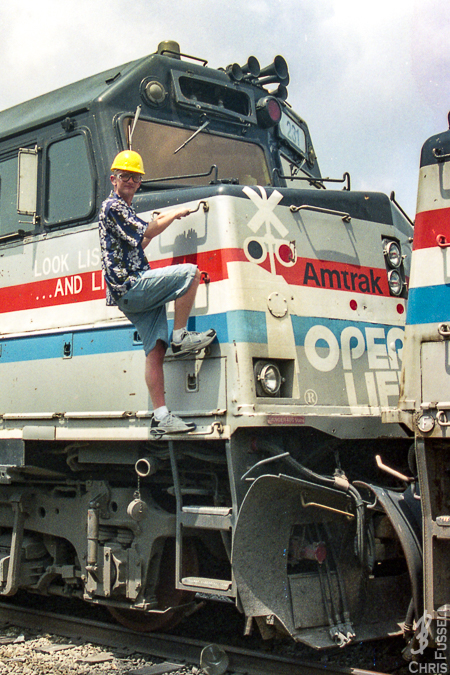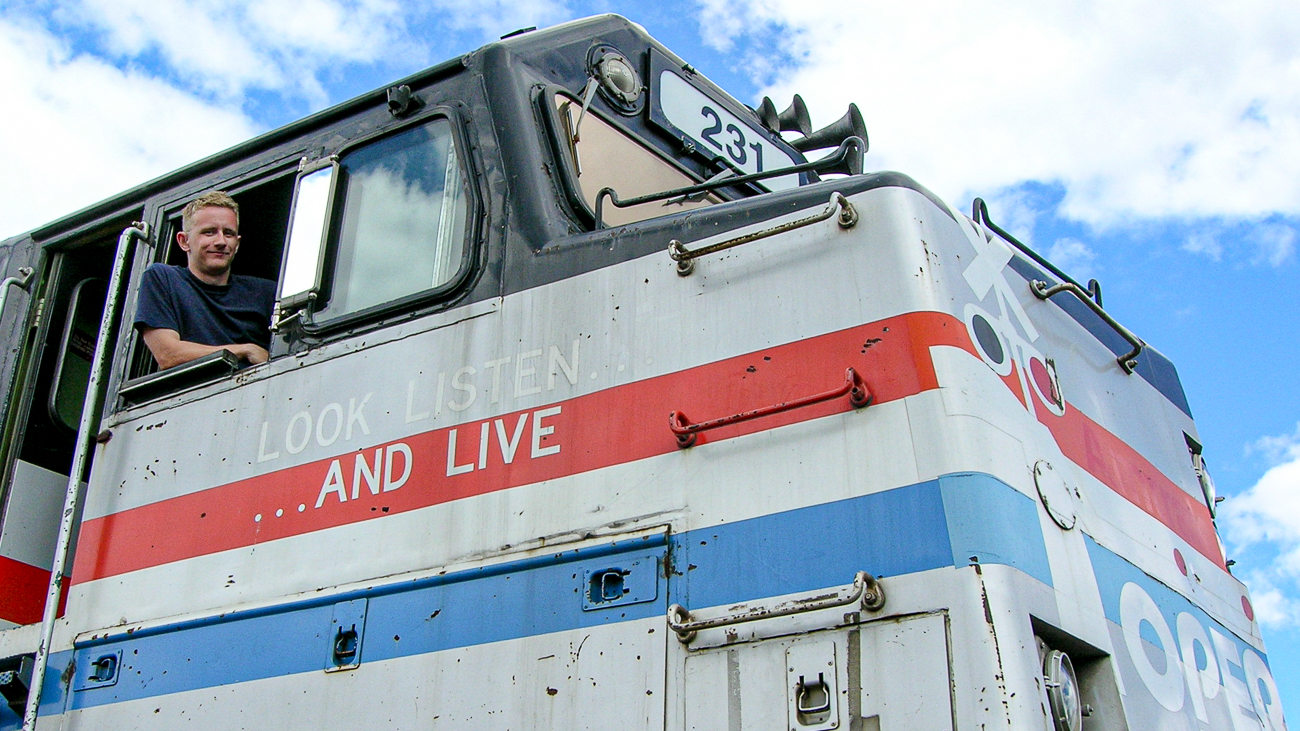
 |
 |
 |
 |

The founders of DynaRail organized an effort in 2002 to save locomotive #231 from imminent scrapping, which was a success, and that effort was repeated with the saving of locomotive #6976 from similar scrapping in the following year. The ongoing care, maintenance, restoration and operation of such preservation efforts remains our number one goal.
Mission Statement: To dynamically preserve railroad equipment for display, education and operation. To enhance the public awareness of the historical, current and future importance of such railroad equipment.
Organized: July 2002 - Founded/Incorporated: May 10, 2013 in the State of California.
Incorporated as a not-for-profit 501(c)(3) EIN: 462669375
Founders: Christopher Fussell; Lance Gleich; John Magnusson; John Tolmachoff
Board of Directors: Christopher Fussell; Lance Gleich; John Tolmachoff
Reporting marks: DYRX
Equipment: Two locomotives, F40PHR #231 and SDP40F #644 (SDF40-2 ATSF #5266; BNSF #6976)
Amtrak 231
Locomotive 231, which is owned by Dynamic Rail Preservation Inc., was built in July 1977 by Electro-Motive Division of General Motors in La Grange, Illinois. It worked for Amtrak from 1977 through 2001, pulling many trains across the midwest and western parts of the United States, with some trips to the eastern region as well as Canada.
In October 2001, 231 operated its last revenue trip on a San Joaquin train into Oakland, California, and was towed dead-in-train on the California Zephyr to Chicago, and then to Beech Grove, Indiana for disposition. Chris Fussell, a fan of the locomotive, then raised over $30,000 in ten days in fall of 2002 to purchase the locomotive for preservation.
After it was transported from Indiana to the Brooklyn Roundhouse in Portland, Oregon, 231 was donated to the Friends of SP 4449 Inc. a volunteer organization Chris volunteered at. The 231 made its public debut at the future site of the Oregon Rail Heritage Center with SP 4449 in 2003.
Work on 231's engine and body took place at the Brooklyn Roundhouse, where it had its turbocharger rebuilt. A temporary paint job in the same scheme worn by SP 4449 was applied before it vacated the roundhouse (along with other artifacts and organizations) and went into storage in northwest Portland. While in storage, its head-end power and traction motor cables were stolen by copper thieves, and its windshield was extensively damaged by shotgun. With no immediate solution in place, the original donors who donated the locomotive formed Dynamic Rail Preservation to take ownership and relocate it to prevent further damage. 231 was relocated to Ogden, Utah, then Boulder City, Nevada where restoration work continues.
Amtrak 644 / AT&SF 5266 / BNSF 6976
Locomotive 644/6976 was built in August 1974 by Electro-Motive Division of General Motors in La Grange, Illinois. It operated Amtrak trains from 1974 through 1984, primarily trains serving southeastern United States. Amtrak 644 was sold to Atchison, Topeka, and Santa Fe Railway, and it went to San Bernardino, California to be rebuilt as a freight locomotive and repainted as AT&SF 5266. It operated on freight trains throughout the western United States as Santa Fe, and later, the Burlington Northern Santa Fe (BNSF) where it was renumbered to 6976.
In 2002, the 6976 was painted blue and silver as part of a promotional event between BNSF and Maersk Sealand. When it was retired and slated for scrap, private funds were raised to purchase the locomotive from BNSF, and the locomotive was subsequently donated to the Northwest Rail Museum organization in Portland, Oregon. The 6976 operated on some trips with SP 4449 steam locomotive as well as freight trains for a local shortline company, until it vacated the Brooklyn Roundhouse used by various non-profit organizations (due to the expansion of the intermodal yard, the roundhouse was demolished), and went into storage in northwest Portland, Oregon. While in storage, it was vandalized by copper thieves, and with no immediate solution in place, the original donors who donated the locomotive formed Dynamic Rail Preservation to take ownership and relocate it to prevent further damage. The 6976 was relocated to Ogden, Utah, then Boulder City, Nevada where restoration work and operation continues.

Why the #231? By: Christopher Fussell
I am often asked why I wanted a certain F40 locomotive from a lot containing over 100 F40s that had at least a dozen units that were in better mechanical and cosmetic condition; simply put, I grew up with the 231, and it made an impression on me during those adolescent years. I had traveled on Amtrak numerous times with family and friends, and when I took my first solo train ride during my early teen years, I studied the locomotives up close before and after riding that San Diegan train, noting that 231 was one of two units powering it. I continued to see 231 regularly when it passed through Portland, Oregon during my high school years, and even more so when I got an apartment of my own next to Portland Union Station. By that time, the number of F40s in service on the west coast had dwindled to a handful.
My interest in transportation systems and railroads had been building for several years before I graduated from high school, and I began volunteering for a local steam preservation organization at the Brooklyn Roundhouse in 2000, which involved three steam locomotives, several diesels and a fleet of passenger cars. It was at the roundhouse where I learned the art of restoration, resurrection, and operation of such historic railroad equipment, and in working with fellow volunteers, I learned of their passion to preserve such artifacts for future generations. Some of that passion derived from past efforts (or lack thereof) to preserve significant railroad equipment that ultimately fell through the cracks; "it should have been saved;" "somebody should save it;" "why didn't anyone save it?" These conversations at the lunch table, along with helping others work toward a common goal in rail preservation, made me wonder what my passion would ultimately be when I reached the age of my mentors, ironically, while locomotive 231 continued to operate through the Brooklyn Yard, sometimes with volunteers working as engineer of that run who'd play a tune with the horn for everyone at the Roundhouse.
As I became more involved with transit systems, and volunteering for the SP 4449 steam locomotive, I figured my passion would lie in reviving former interurban routes with new light-rail trains, and helping keep steam locomotives alive for generations to come. One evening in May 2001, we had moved the 4449 from the roundhouse to Union Station for a train excursion down the Columbia River Gorge the next day; I was ecstatic to embark on what would be my first experience with high speed mainline steam (on the crew nonetheless) through one of the most beautiful parts of the country.
After wrapping up a few loose ends at work the night before the big steam trip, I was on my way home when I encountered three teenagers who proceeded to knock me to the ground, and stomp on my head and torso, during this act of robbery. I ended up in the hospital with severe bruising and fractures, and it took nearly a week until I recovered well enough to walk straight again. Bootprint marks remained on my face for several weeks after that. The three teenagers were caught, thankfully; when the police caught up with them, they were found with not only my belongings, but also other victims', an indication that they were involved in a string of numerous robberies and assaults over a period of several months. I was lucky to be alive.
When I returned to my apartment the following week, I continued to recover from my injuries, but what I was also really upset about was missing the steam excursion I was set to go on the morning after the assault. I was livid. This was my passion the muggers toyed with, and I was determined to fulfill it to the maximum by doing everything I could while they sat in their 8x9' jail cell. I promised I would go on as many steam excursions as able, to get involved in various transit advocacy groups, and to live to the fullest. The only question was: where do I start?
As I stood on the balcony of my apartment overlooking Union Station, I could hear the Coast Starlight train approaching, and as the lead of the train popped into view, locomotive 231 rolled forward in charge with its bell clanging. Get busy living, they say, so I picked up a light backpack, got my ticket across the station, took pictures and boarded what would end up being the first ride toward reviving my life's passion. For the next six months, I coordinated my lunch breaks or evening activities to intercept or ride the 231 as it passed through town, including the Brooklyn yard where I continued to participate in restoration projects. When word spread on the internet in November 2001 that 231 had seen its last mile of service on Amtrak, my friends at the Roundhouse encouraged me to "go save it". It was a rather daunting idea, since I was only 19 years old, and didn't have the means to willy-nilly go pick up a train locomotive that could run into the hundreds of thousands dollars.
I thought I should go see it one last time before it was to be scrapped, so I took a trip to Amtrak's Beech Grove facility in July 2002 and spent the afternoon going over and through the 231. I had my first photo taken with the locomotive as pictured here, while climbing up to claim the numberboard. After meeting with friends, and the employees there, I became more determined to see if preserving it was truly feasible, and communicated my interest with Amtrak. As a publicly-subsidized corporation, it was difficult for Amtrak to make outright donations, but they were willing to consider a reasonable offer. In late 2002, I entered a preliminary agreement with Amtrak to purchase the locomotive, pending fundraising efforts. Over $30,000 was raised in ten days, and the purchase was completed on December 5th. Locomotive 231 arrived at the Brooklyn Roundhouse on April 25, 2003, ten years to the day following my father's passing, and this newfound adventure was just the beginning!
